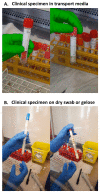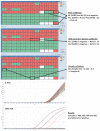SARS-CoV-2 Detection for Diagnosis Purposes in the Setting of a Molecular Biology Research Lab
- PMID: 32824827
- PMCID: PMC7564796
- DOI: 10.3390/mps3030059
SARS-CoV-2 Detection for Diagnosis Purposes in the Setting of a Molecular Biology Research Lab
Abstract
The emergence of the SARS-CoV-2 virus and the exponential growth of COVID-19 cases have created a major crisis for public health systems. The critical identification of contagious asymptomatic carriers requires the isolation of viral nucleic acids, reverse transcription, and amplification by PCR. However, the shortage of specific proprietary reagents or the lack of automated platforms have seriously hampered diagnostic throughput in many countries. Here, we provide a procedure for SARS-CoV-2 detection for diagnostic purposes from clinical samples in the setting of a basic research molecular biology lab. The procedure details the necessary steps for daily analysis of up to 500 clinical samples with a team composed of 12 experienced researchers. The protocol has been designed to rely on widely available reagents and devices, to cope with heterogeneous clinical specimens, to guarantee nucleic acid extraction from very scarce biological material, and to minimize the rate of false-negative results.
Keywords: COVID-19; RTqPCR; SARS-CoV-2; diagnosis.
Conflict of interest statement
The authors have declared that no competing interests exist.
Figures







References
-
- Fischer M., Schirrmeier H., Wernike K., Wegelt A., Beer M., Hoffmann B. Development of a pan-Simbu real-time reverse transcriptase PCR for the detection of Simbu serogroup viruses and comparison with SBV diagnostic PCR systems. Virol. J. 2013;10:327. doi: 10.1186/1743-422X-10-327. - DOI - PMC - PubMed
-
- Pan Y., Long L., Zhang D., Yuan T., Cui S., Yang P., Wang Q., Ren S. Potential False-Negative Nucleic Acid Testing Results for Severe Acute Respiratory Syndrome Coronavirus 2 from Thermal Inactivation of Samples with Low Viral Loads. Clin. Chem. 2020;66:794–801. doi: 10.1093/clinchem/hvaa091. - DOI - PMC - PubMed
-
- Artesi M., Long L., Zhang D., Yuan T., Cui S., Yang P., Wang Q., Ren S. A recurrent mutation at position 26,340 of SARS-CoV-2 is associated with failure of the E-gene qRT-PCR utilized in a commercial dual-target diagnostic assay. J. Clin. Microbiol. 2020;66:794–801. doi: 10.1128/JCM.01598-20. - DOI - PMC - PubMed
Grants and funding
LinkOut - more resources
Full Text Sources
Miscellaneous

